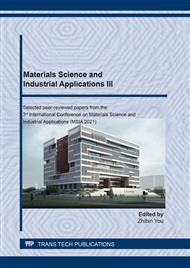p.108
p.114
p.120
p.129
p.135
p.141
p.147
p.152
p.157
Finite Element Simulation Analysis on Residual Stress Relief of 7075 Aluminum Alloy Ring
Abstract:
Vibration stress relief (VSR) and thermal stress relief (TSR) are important method to eliminate the residual stress of structural parts. The thermal vibratory stress relief (TVSR) is a new method to decrease and homogenize the residual stress. Based on the stress relaxation tests and the equivalent vibration equation of modal analysis, the creep constitutive model and the bilinear isotropic hardening plasticity material model (BISO) are combined to establish the numerical simulation model of TVSR of 7075 aluminum alloy ring part. The simulation results show that four different initial blank residual stress levels are obtained after quenching process, and the residual stress elimination and homogenization effect of TSR and TVSR is better than that of VSR. TVSR has a better effect on both residual stress elimination and homogenization, and the residual stress relief rate can reach more than 20%.
Info:
Periodical:
Pages:
135-140
Citation:
Online since:
May 2021
Authors:
Price:
Сopyright:
© 2021 Trans Tech Publications Ltd. All Rights Reserved
Share:
Citation:


